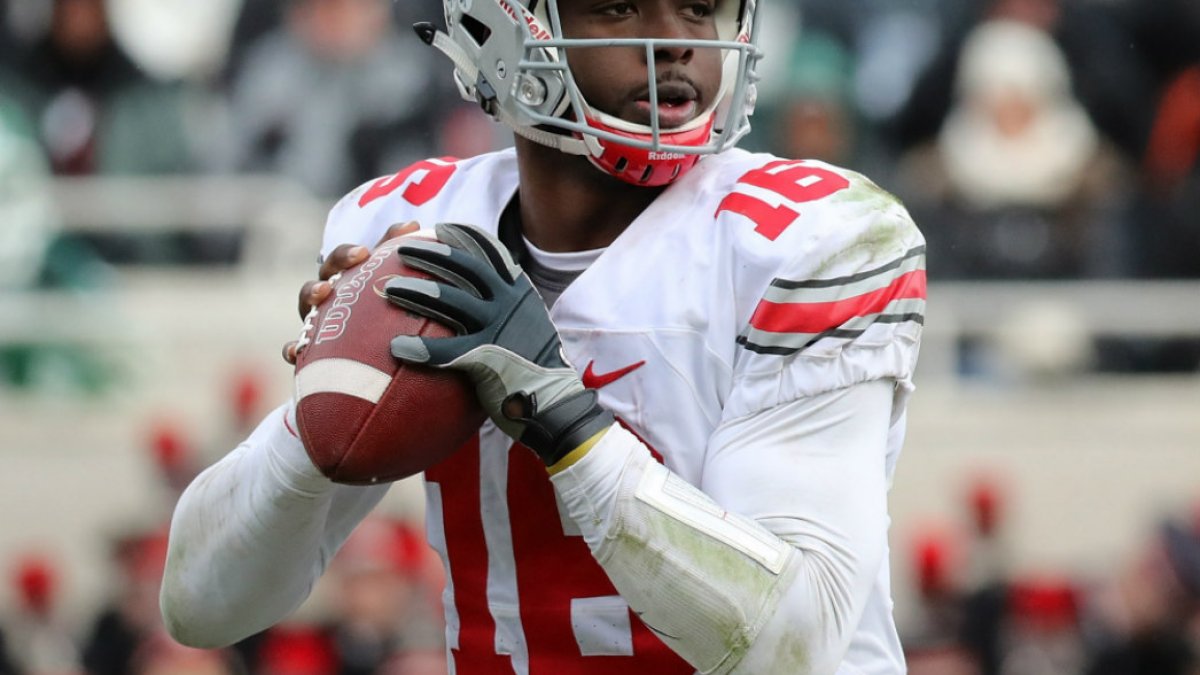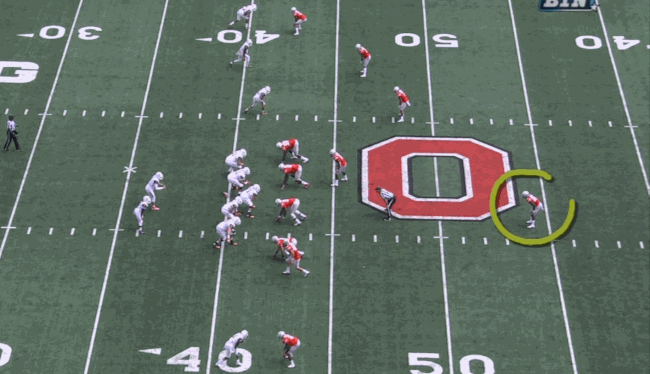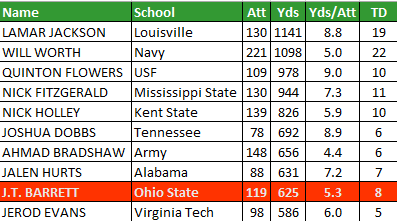Ahead of rivalry week, we’re breaking down the top matchups from each team’s perspective. Today, senior analyst Steve Palazzolo and Big Ten analyst Josh Liskiewitz join forces to take on The Big Game. Here’s what each team needs to do to win, and what you should be watching for come gametime:
How Ohio State can win
While it is no big surprise this year’s version of “The Game” is playing a critical role in deciding which school will represent the Big Ten east in Indianapolis next week, the national stakes probably are a surprise, especially given the expectations we had for Ohio State coming into the season.
The reasons Ohio State should win on Saturday are plentiful, but the single biggest advantage the Buckeyes have is clearly at quarterback. Barrett is easily our highest-graded Big Ten quarterback, and while Michigan’s Wilton Speight is the clear number two, his left shoulder injury will either keep him out of action for the second-straight week or severely limit him on the field. Barrett’s running ability is certainly a significant advantage, but when facing a defense like Michigan’s a QB needs to perform under pressure, and Barrett has certainly done that this year. He has yet to throw an interception this year when under pressure from the rush, and his performance against the blitz has been outstanding. When opponents have sent the extra man, he has completed 61.9 percent of his passes, thrown 10 touchdowns with no picks and has a QB rating of 121.8.
While Barrett’s top receiver is clearly the duel-threat Curtis Samuel, it’s his top RB Mike Weber who may pose the bigger threat, based on Michigan’s recent struggles. Weber has forced 40 missed tackles this season on 165 carries, which is the second-best ratio in the Big Ten behind only Iowa’s Akrum Wadley. Against the Wolverines two weeks ago, Wadley forced five missed tackles (his backup, LeShun Daniels, forced four) en route to a 115 yard performance on the ground. Weber is clearly capable of a similar performance, especially considering how strong the offense line play has been. Ohio State ranks among our top ten lines, in part due to the outstanding run blocking of players like C Pat Elflein, and in part due to the fact that three of the five starters have combined to give up just one sack this season.
The defense being played in Columbus has been every bit as outstanding as the offense, and has carried the Buckeyes through rough patches this season. Ohio State’s top four pass-rushers all have at least 27 hurries on the season; the only school in the country that can boast more raw production from its top four players is Alabama. DE Tyquan Lewis comes in the hottest, as he notched a sack and four total pressures against Michigan State last week. Ohio State is equally adept at stopping the run, as nine starters have run defense grades of at least 78.7 or higher.
The secondary may not be tested significantly if John O’Korn is the quarterback on Saturday, but it’s worth noting it has possibly been the most consistent unit on the entire team. CBs Gareon Conley and Marshon Lattimore have combined for seven interceptions and 12 other passes defended, with just one touchdown yielded between the two of them. Safety Malik Hooker leads the Big Ten with five interceptions, and QBs have a rating of just 38.2 when he is the primary defender in coverage. Michigan head coach Jim Harbaugh is likely to throw the kitchen sink at the Buckeyes, but with such strong play across the board on the back end, Ohio State looks well-equipped to shut down the Wolverines.
— Josh Liskiewitz
How Michigan can win
The road map for a Michigan win starts and ends with their defense which ranks second overall in PFF’s cumulative grades to only Alabama. They start with perhaps the most disruptive defensive lines in the nation and that front-four can rush the passer and play the run. Michigan has pressured opposing quarterbacks on 52.3 percent of dropbacks, the highest rate in the nation, and that’s going to be the key to slowing down Ohio State’s passing attack. In Ohio State’s only loss of the season to Penn State, QB J.T. Barrett was pressured on 52.8 percent of his dropbacks and that proved to be the difference in the game. With interior rushers Ryan Glasgow (85.6 pass rush grade, 12th in the nation), Maurice Hurst (84.7 pass rush grade, 17th in the nation) and edge rusher Taco Charlton (81.5 pass rush grade, 36th in the nation), Michigan can bring the heat from all angles. And that’s not even mentioning the strong play from Chris Wormley, Chase Winovich, and Rashan Gary who round out the nation’s deepest defensive line. Charlton is especially key as his grade doesn’t do him justice as he’s played hurt for much of the season and he’s been a dominant presence both against the run and as a pass-rusher in recent weeks.
If the pass rush gets home, it makes things much easier on the back end where Michigan also features one of the best secondaries in the country. Cornerback Jourdan Lewis had our top coverage grade a year ago and he currently ranks fifth overall in the nation at 88.3. The other story on the back end has been the emergence of fellow CB Channing Stribling who currently boasts the No. 17 coverage grade at 86.2. That pairing makes it nearly impossible to complete passes outside and the duo ranks second and third in the nation in opposing passer rating among cornerbacks with at least 30 targets (12.7 passer rating when targeting Lewis, 21.2 when targeting Stribling). Of course the No. 1 and No. 4 corners on that list play for Ohio State, but that fact has no place in this “Why Michigan Wins” section.
Beyond the corners, safety/linebacker Jabrill Peppers is the X-factor for the defense as he lines up in a number of spots and his 83.5 grade against the run ranks second among Power-5 safeties. He’s best when freed up to roam (more on that below), but his ability to affect the game from all angles will be a key part of Michigan’s defensive game plan.
The big question, as always, is whether or not Michigan can have enough success on the offensive side of the ball to complement their elite defense. Starting QB Wilton Speight was finding himself before going down to injury and backup John O’Korn will get the nod after a rough first start against Indiana last week. Because of his inconsistency, the run game must be a major part of Michigan’s attack and they need the De’Veon Smith that ran for 114 yards against Maryland and 158 yards against Indiana last week, not the Smith who was shut down for 28 yards on 12 carries against Iowa in their only loss. Smith ranks 67th in the nation in carries, but 34th in missed tackles forced with 34. Finally, keep an eye on Peppers who has been a small part of the offense throughout the year, but an O’Korn-led offense should inspire more direct snaps to Peppers as Michigan taps into its best players in the biggest game of the year. Peppers has averaged 7.1 yards per carry to go with three touchdowns this season and he may see 10-plus carries in this one.
— Steve Palazzolo
Matchup to watch
J.T. Barrett versus Jabrill Peppers
We mentioned Peppers as the Swiss-army knife that Michigan deploys on the defensive side of the ball and he’ll be the key figure to stop Ohio State QB J.T. Barrett in both the designed running game and as a scrambler on passing plays. Peppers has already dabbled in a “spy” role at times this season, keeping a close eye on opposing quarterbacks and mirroring their every move, but Michigan has yet to play a quarterback as dangerous as Barrett is on the ground. His 625 yards in the designed run game rank ninth among FBS quarterbacks and fifth in the Power-5 and he’s added another 184 yards on 27 scrambles (6.8 yards/attempt). Last week against Michigan State, Barrett struggled to throw the ball in heavy winds and Ohio State adjusted and ran their offense through Barrett on the ground. Given the pressure Michigan can create up front and their top-notch cornerbacks on the outside, it may be another game in which Barrett pairs with RB Mike Weber and RB/slot Curtis Samuel to move the ball. If that’s the case, Peppers’ presence in the box may even up the numbers advantage a mobile quarterback usually brings to the designed run game.
While Peppers can get blocked at the point of attack, he’s at his best when he’s the extra man in the box, left to read and attack plays from the back side and that’s a big reason he is tied for fifth in the nation with 10 tackles for loss in the run game. If Peppers can contain Barrett, Ohio State may struggle to move the ball against the stout Michigan defense.
— Steve Palazzolo






 © 2024 PFF - all rights reserved.
© 2024 PFF - all rights reserved.